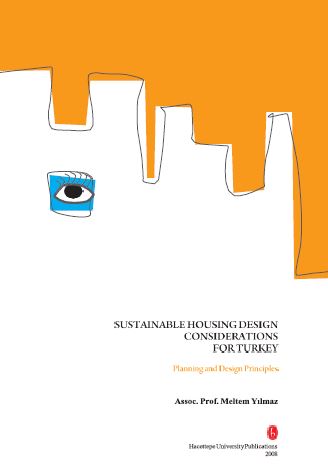Sustainable Housing Design Considerations For Turkey:Planning and design principles

- YazarAssoc. Prof. Meltem Yılmaz
- Fiyat: 22.00 TL Hacettepe Öğrencileri İçin Fiyat: 17.00TL
- Yayın Yılı: 2008
-
Turkey is a vast country with varied climate, ranging from very hot to the Mediterranean to very cold; it is also a populace nation with close to 70 million inhabitants, the majority of which is young and will require new housing in the coming two decades. It is estimated that more than 75 percent of the population is living in urban areas and a significant portion, almost 60 percent of it, belonged to lower income group, many of whom are living in gecekondus, or squatter settlements1 (please get the latest stats). Therefore, it is vital for design professionals to look for cost effective sustainable housing design solutions for the poor and rapidly growing middle-classes of Turkey.
As the Standard of living in Turkey improves patterns of energy consumption, particularly in its urban areas and housing is also changing: Traditionally very few people owned cars and homes were neither heated nor air-conditioned, but now, the use of energy for urban transport and heating and cooling of buildings is growing. Although well endowed with renewable hydro power resources, Turkey has very limited oil and natural gas reserves; hence, it is essential to seek energy efficient sustainable housing solutions.
Working with my colleagues and me at McGill University, from August to December 2006, under the auspicious of TÜBİTAK, the Turkish Scintific Research Institute, Dr. Meltem Yılmaz, developed guidelines for Sustainable housing designs for Turkey. Her fieldwork also included the study of several successful Canadian sustainable housing projects realized in the last decade. The objective was not to copy these examples, but to look at them critically. and learn both positive and negative aspects of such model projects. This was the first collaborative research project supported by TUBITAK between McGill University School of Architecture and Hacettepe University. I am pleased to see that Dr. Yilmaz's work is being published by the Hacettepe University.
As an architect involved in the field of human settlements and housing I am interested in understanding and addressing challenges related to where and how ordinary people live, the choice of which, particularly in the west, has already been made. Major environmental challenges of today such as climate change and environmental degradation are the result of these human choices. More importantly, the future of our planet hangs in balance; it will be determined by the kind of built environment -cities- we will create in the developing and transitional economies like Brazil, China, India and Turkey. This small book takes a modest but concrete step showing us how we can manage to turn around our voracious and energy hungry urban sprawl and wasteful ways. This is a timely and valuable study which will be useful for students as well as professional architects and planners. It will also serve as a good guide for the decision makers working with local authorities.
